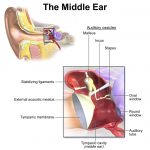Hearing Tests for Adults and Children from Birth Onwards
Transient Evoked Otoacoustic Emissions
Although this is not a hearing test, passing a Transient Evoked Otoacoustic Emission test provides a good indication that the ear is working well. It is based on the principle that the ear will produce a faint sound (echo) when it hears.
A small probe, containing a speaker and a microphone, is placed into the patient’s ear via a small earpiece. A measured clicking sound is played and any echo, which is produced, is measured. This can be a very quick test and the results are available immediately. This test is best done while the patient is settled. It can often be difficult to obtain results if the test room is not quiet or if the patient is restless. The video below shows an Otoacoustic Emissions test taking place.
Auditory Brainstem Response
This test is commonly used in babies and is sometimes used as an automated screening test from birth. An insert will be placed in the baby’s ear and three or four small sensors are placed on the baby’s head to detect the brains response to sound stimuli. Better results are obtained if the baby is asleep.
This test can also be carried out by an experienced audiologist as a more accurate diagnostic assessment of hearing function on patients of any age. The sensors will detect any information, which passes along the auditory nerve. This information is then interpreted by the audiologists. It is essential that the patient is asleep for this test.
Tympanometry
Tympanometry is a test used to detect disorders of the middle ear. Air pressure in the ear canal is used to test the condition and mobility (movement) of the tympanic membrane (ear drum). This is not a hearing test, but a test of middle ear function. A small insert is placed in the ear and a pump gently causes a pressure change in the ear canal. If the eardrum doesn’t move freely in and out with the pressure change, then it tells us that there is likely to be congestion in the middle ear. This congestion may cause a temporary hearing loss. The video below shows Tympanometry testing taking place.
Hearing Tests from Six Months of Age
As a child grows older, it is possible to obtain more information about their hearing. We may use toys to make it seem like a game.
Visually Reinforced Audiometry
This form of audiometry offers the child a visual reward when they correctly turn in response to a frequency specific sound presented via a speaker, ear inserts, headphones or a bone conductor (a small device that is placed on the child’s head). As soon as your child becomes old enough to sit and turn their head in response to a sound, they may be able to be tested successfully and accurately using this method. The video below shows Visually Reinforced Audiometry testing taking place.
Hearing Tests for Adults and Children from around 2 Years of Age
Pure Tone Audiometry
This test requires the patient to co-operate. The patient will be asked to respond when they hear a sound. These sounds are generated by an audiometer at a specific intensity and frequency and played through a speaker, headphones, ear inserts or a bone conductor (a small device that is placed on the child’s head). Adults and older children and will be asked to press a button in response to the sound. If the patient is a younger child, depending on their level of understanding, play may be introduced by using toy figures, pegs or bricks etc. Your audiologist will record the quietest sound that the patient can hear on an audiogram.
An audiogram records volume of sounds on the vertical axis. This is measured in decibels (dBHL) starting with quiet sounds near the top of the graph and the sounds becoming louder as they move down the audiogram. The horizontal axis measures the frequency or pitch of sounds in hertz (Hz) with the lowest pitches towards the left of the audiogram and the pitch becoming higher as we move towards the right of the audiogram – a bit like the keys on a piano.
For a fuller explanation of your audiogram, please visit the Hearing Link website.
Speech Discrimination Assessments
The audiologist will assess the patient’s ability to discriminate speech. Words are played at specific measured intensities. A speaker or headphones are used to eliminate visual cues like lipreading.


